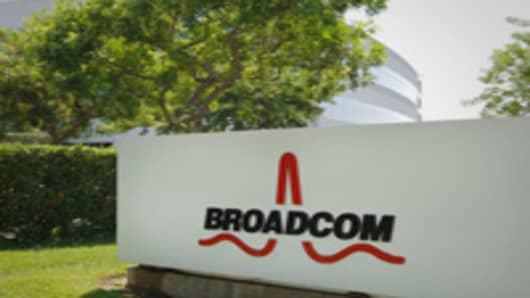Be that as it may, the company has always been one that has shown it can stand out from its peers. Unlike its rivals, Broadcom also generates revenue from another popular and highly profitable stream — routing and switching equipment, one where it competes with (among others) Cisco, Dell, and Hewlett-Packard. As tough of a competition this may pose, it makes sense to expect good things from Broadcom if for no other reason than Cisco’s own recent study and Broadcom’s own recent earnings performance — one where although it beat estimates, offered outlook that was somewhat uninspiring.
The Broadly Better Quarter
Last week, the company reported net income of $88 million, or 15 cents per share, for the period ending in March, compared to having earned $228 million or 42 cents per share in the same period of a year ago. The company attributed the decline (among other things) to weaker sales of handsets from one of its biggest customers in Nokia — this is despite strong iPad sales. It earned 65 cents per share (excluding one-time items) and beating analysts’ estimates polled by Thomson Reuters as revenue arrived at $1.83 billion, up slightly from $1.82 billion a year earlier — also topping the Street’s expectations.
For the quarter, operating costs grew 12 percent to $1.78 billion from $1.58 billion. Although the higher expenses include $86 million in settlement costs, it did serve to raise some red flags for investors to witness a disappointing decline in profits in consecutive reports. On the positive side however, the company does expect better numbers for the second quarter as sales are expected to arrive between $1.9 billion and $2 billion — reaching the higher range of analysts’ estimates. Overall, I have to say that the numbers were broadly better than investors could have expected as revenues arrived at the higher end of what the company initially projected.
Moving Forward
During the call, it was clear that management was somewhat cautious with not appearing too optimistic and offering hints that the company’s first-quarter numbers reflected a bottom (of sorts) relative to outlook for the coming quarters. It was clear that the company not only demonstrated enough areas of strength in the form of new products and program ramps, but that these improvements should enable Broadcom to drive growth in the second quarter as well as the balance of the year. Also the slight decline in profits did not really come as much as a surprise — at least (for investors) that should not have been the case when considering Qualcomm recently reported supply chain issues that impacted its own revenues.
As the battle for chip supremacy continues, the prevailing question will always be where does Broadcom rank among other chips? Although it is not as sexy as ARM Holdings, but when discussing its growth potential in devices chip technology, investors also have to be pleased about its overall business — one that also includes network equipment gear for the enterprise, an area that has recently shown that it is on the rebound. So from that standpoint, not only is it battling chips, it also has the added advantage of being able to steal market share from the networking components as well — a differentiator that only Intel has the ability to rival.
Bottom Line
As a value investor, considering a stock such as Broadcom, one that trades at $34 with a price-to-earnings ratio of 25, the very first thing that I will concede is that the stock is not cheap. But then again, “cheap” has never served as criteria for investing in technology. For that matter it trades at a lower multiple than ARM which carries a price-to-earnings ratio of 53 and just slightly higher than both Qualcomm and Texas Instruments. So as Broadcom’s earnings may generate some concerns, it would be wise to add shares on weakness and sell ARM into strength for investors looking for a good play on chips.
All of that notwithstanding, placing a bet here on Broadcom will require some time for reward, but over the next 12 to 24 months, it is not out of the question for the stock to approach the $50 level and reach a near term target of $40 by the end of the year.
Additional News: Samsung’s Mass Appeal Gives It Edge Over Apple: Experts
Additional Views: Can a Bionic ARM Still Pay Off?
_____________________________
CNBC Data Pages:
______________________________
Disclosures:
TheStreet’s editorial policy prohibits staff editors, reporters, and analysts from holding positions in any individual stocks.
Disclaimer


